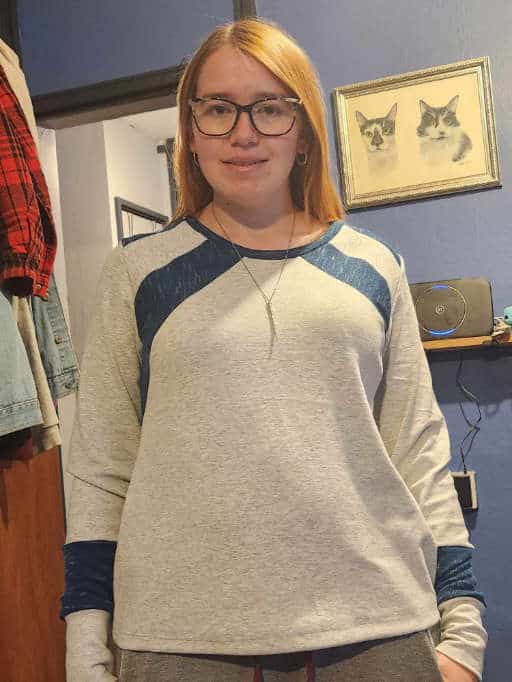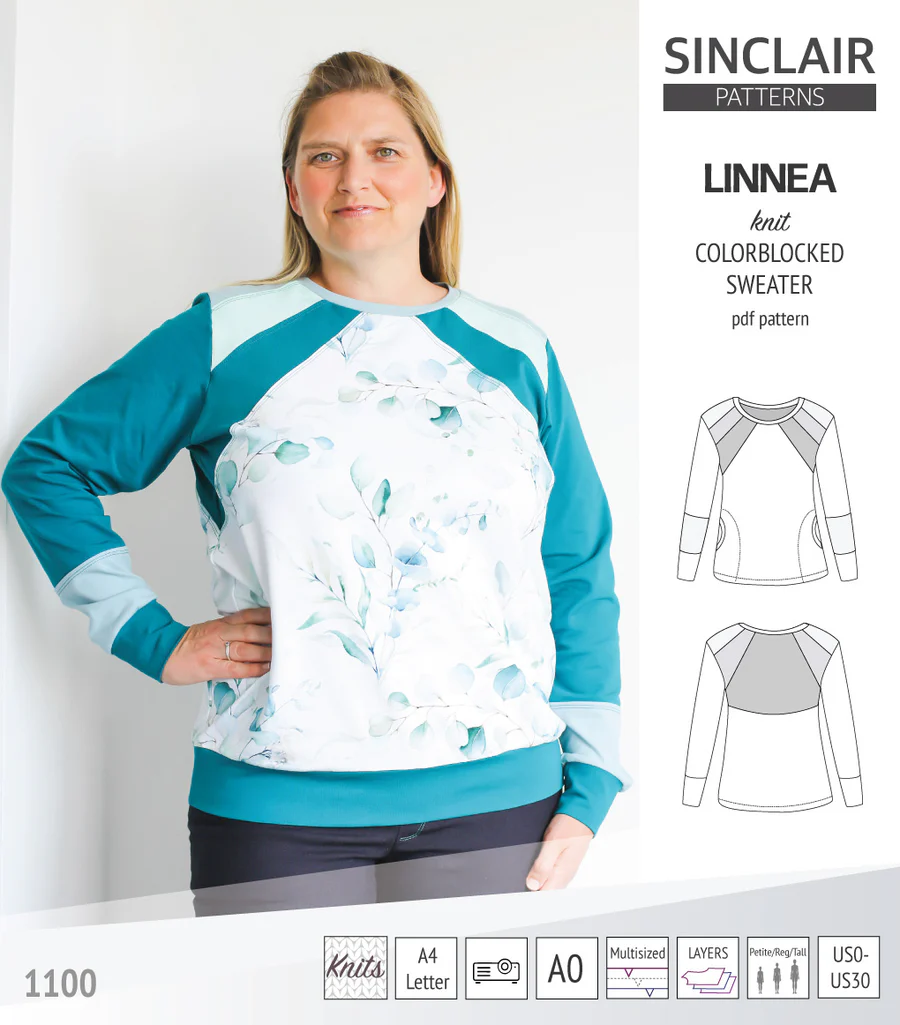This particular version of Sinclair linnea knit colourblock sweater pattern uses a light grey marl French terry for the main body. The fabric has a lovely texture and is soft without being too thick or heavy. It’s breathable but still warm, making it ideal for layering over a t-shirt or under a coat. French terry is one of my go-to fabrics because it’s easy to sew, comfortable to wear, and drapes nicely without clinging. The light grey works well as a neutral base and lets the colourblock panels really pop.
The blue sections were made using a 2-way stretch marl jersey that I only had a few scraps of. It had been sitting in my fabric stash for a while, waiting for the right project. The Linnea was perfect for it because the colourblock sections don’t require a lot of fabric, which makes it a fantastic pattern for using up smaller pieces or leftovers from other projects. It felt very satisfying to find a use for that blue jersey and to see how beautifully it paired with the grey French terry. The textures and tones of the two fabrics complement each other well, giving the finished sweater a polished, cohesive feel.
Another reason I love this pattern is how it lends itself to experimentation. Depending on the fabrics you use, you can create very different looks. I’ve made a more casual version in sweatshirt fleece, and another in slightly drapier knits for a softer, more relaxed fit. But this version, with the French terry and stretch jersey, hits that perfect middle ground. It’s structured enough to feel neat but still comfortable and easy to wear.

The Sinclair linnea knit colourblock sweater pattern
One of the great things about the Linnea colourblock sweater pattern is its ability to elevate basic fabrics. You don’t need anything fancy or expensive. The colourblock design naturally draws the eye and gives a sense of shape and movement. It’s also great for those who enjoy playing with combinations. You could go with two shades in the same tonal family, or go bold as we’ve done here.
As far as the sewing process goes, I’d definitely recommend this pattern to confident beginners and above. It doesn’t involve any tricky fastenings or finishing techniques, and the instructions are clear and easy to follow.
The panels are all neatly marked, and once you’ve made it once, it becomes quite intuitive. I find it quite a satisfying sew, especially when you get to piece the colourblock sections together and start to see the final shape take form. It’s a bit like putting together a puzzle, and the result always feels rewarding.
When it comes to wearability, this sweater is hard to beat. It’s warm and cosy, perfect for winter or those chillier spring days when you still want something comforting but not too heavy.
The relaxed fit makes it easy to layer underneath, and the neckline sits comfortably without being too high or too low. I often find that I end up wearing this one around the house as much as I do out and about because it’s just that comfortable. It’s the kind of piece you throw on and instantly feel a bit more put together, even if you’re only running errands or staying in.
If you’re thinking about trying this pattern, here are a few reasons why I think it’s such a good one to add to your collection:
• Great for stash-busting – The colourblock panels mean you can use up small amounts of leftover fabric. It’s ideal if you’ve got scraps you’ve been saving for something special.
• Beginner-friendly construction – Despite looking detailed, the pattern is easy to assemble and the instructions are very user-friendly.
Kat’s version of the colourblock sweater
For this version, I did make a few small adjustments to suit my fabric choices. Because the blue jersey had a bit less stretch than the French terry, I was careful when joining the pieces to avoid puckering. I also stabilised the shoulder seams with a strip of clear elastic to prevent them from stretching out over time. These are small tweaks but they make a big difference in how the garment holds up with wear and washing.
Another tip I’d offer is to pre-wash your fabrics and check the stretch and recovery before you start cutting. That way, you’ll avoid any surprises and can feel more confident that your finished piece will fit and wear well. Also, taking the time to press seams as you go helps the panels lie smoothly and gives a clean, professional finish.
Now that I’ve made this version of the colourblock sweater, I’m already planning a couple more. I’d like to try one in bolder colours for spring, maybe with a bright coral or teal. I also think it would work really well in monochrome, imagine black, charcoal, and grey panels for a more dramatic look. The possibilities are endless, and once you’ve made it once, you’ll find it hard to stop thinking of new combinations.
Overall, this version of the Sinclair Linnea pattern has definitely earned its place as my favourite. It’s warm, stylish, comfortable, and fun to make. If you enjoy sewing garments that make the most of your fabric stash while still looking smart and intentional, I highly recommend giving this one a try. Whether you’re new to colourblocking or a seasoned pro, the Linnea offers a lovely canvas to play with fabric, texture, and creativity.
